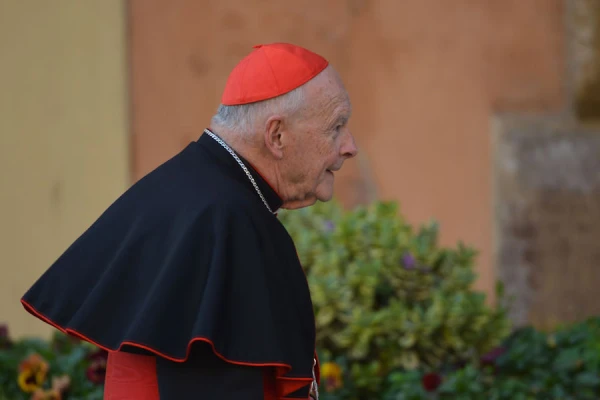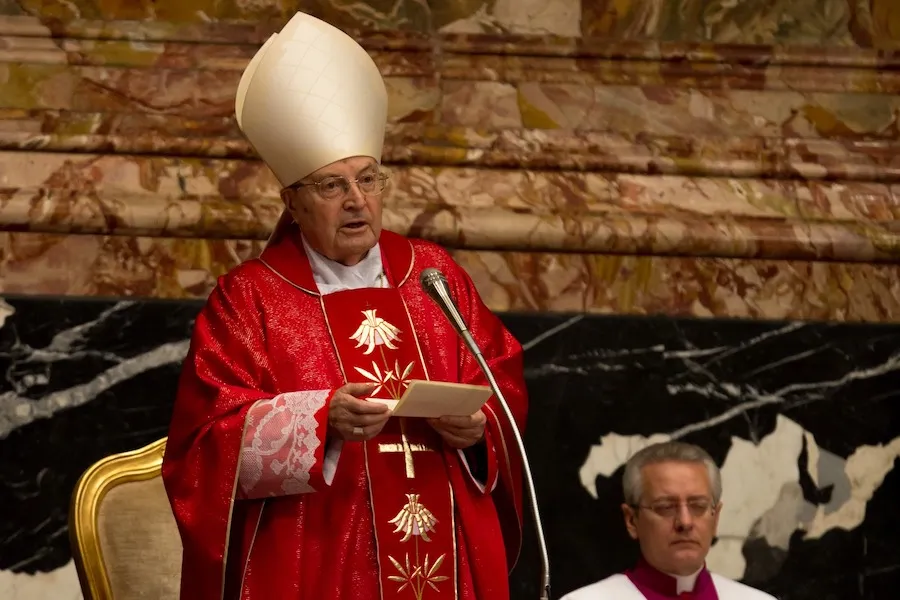
Vatican City, Nov 10, 2020 / 10:30 am (CNA).- The Vatican’s report on Theodore McCarrick released Tuesday includes a letter written by an American cardinal in 1999, who objected to McCarrick’s potential appointment to higher office, on the basis of existing allegations of misconduct, including incidents involving sharing a bed with seminarians at a New Jersey beach house.
On Oct. 28, 1999, Cardinal John O’Connor of New York wrote a letter to the U.S. apostolic nuncio, Archbishop Gabriel Montalvo, after the cardinal learned that McCarrick was under consideration to be appointed his successor as archbishop of New York. That letter was shared with Pope John Paul II shortly thereafter, the Vatican’s McCarrick Report states.
“With deep regret, I would have to express my own grave fears and those of authoritative witnesses cited above, that should Archbishop McCarrick be given higher responsibility in the United States, particularly if elevated to a Cardinatial See, seem[] sound reasons for believing that rumors and allegations about the past might surface with such an appointment, with the possibility of accompanying grave scandal and widespread adverse publicity,” O’Connor wrote.
He added that “while charity must prevail and the benefit of the doubt always given to the ‘accused,’ the good of souls and the reputation of the Church must be seriously considered and the potential for scandal given equally serious consideration.”
“I can not, therefore, in conscience, recommend His Excellency, Archbishop McCarrick for promotion to higher office, should this be the reason for your inquiry concerning him at this time. On the contrary, I regret that I would have to recommend very strongly against such promotion, particularly if to a Cardinatial See, including New York.”
O’Connor wrote in 1999 that authoritative sources had told him that stories about McCarrick frequently arranging for seminarians to visit a New Jersey beach house circulated in the dioceses of Newark and Metuchen, specifically that “the arrangement was for seven seminarians, six of whom shared the guestrooms and one of whom shared the bed with the Archbishop.”
He said that a key authority had informed him that he believed “that some problem did occur involving at least one person, perhaps a priest, and that Bishop Hughes handled that personally and secretly.”
O’Connor said that he had personally asked a priest psychologist of New York archdiocese to speak with the psychiatrist who was treating a priest involved.
“Both the priest psychologist and the psychiatrist seem convinced that the priests or priests (sic) in treatment were victimized, willingly or unwillingly, in their inappropriate relationship with the then Bishop McCarrick, while Bishop of Metuchen,” O’Connor wrote in the letter. He added that he did not find these findings “definitely persuasive,” but could not dismiss their findings “because of the gravity of the allegations.”
O’Connor also raised concerns about McCarrick’s “seemingly incessant need to travel outside of the archdiocese to different parts of the world,” saying that he questioned whether there could be “any relationship between this seeming need to travel outside the archdiocese and his apparently having put his former alleged inclinations behind him.”
Cardinal O’Connor led the Archdiocese of New York from 1984 until his death on May 3, 2000. He was a major figure of American Catholicism and an outspoken defender of the faith and Catholic moral teaching.
The report notes that O’Connor conducted “the first known inquiry related to concerns over McCarrick’s conduct.” In the early 1990s, O’Connor investigated anonymous complaints against McCarrick ahead of a potential papal visit to Newark. He concluded that allegations of possible misconduct with adults would not present an issue if the pope were to visit Newark.
In 1997, McCarrick was being considered to lead the Archdiocese of Chicago. While he was generally praised as a strong candidate, O’Connor questioned whether he would provide the “firmness necessary to ‘compensate’ for the prevailing permissiveness” following the tenure of Cardinal Joseph Bernardin, the report said. However, it added that O’Connor “admitted” that McCarrick could be effective in addressing theological abuses. McCarrick was ultimately not selected for the role.
The 1999 letter from O’Connor is included in the 449-page McCarrick Report on pages 131-140. The report indicates that “it is reasonable to infer” that Bishop James T. McHugh, the former auxiliary bishop of Newark, and Bishop Edward T. Hughes, the bishop emeritus of Metuchen, were O’Connor’s sources of information regarding these allegations.
O’Connor wrote that John Paul II had made clear to him in a meeting early in the summer of 1999 that he was considering appointing McCarrick to another diocese, potentially as O’Connor’s successor in New York.
After this, O’Connor expressed concern to the nuncio Montalvo in late July, saying that he was aware of “some elements of a moral nature that advised against” McCarrick’s consideration. Montalvo requested that O’Connor put his concerns in writing.
O’Connor’s letter is dated Oct. 28, only weeks after the cardinal’s release from hospital following surgery to remove a brain tumor. O’Connor died from this tumor the following May.
In the letter, O’Connor wrote that he was concerned by events related to him by “absolutely impeccable authorities as occurring in the Archdiocese of Newark during this past year.”
Among these is that “after Archbishop McCarrick was appointed as Ordinary, it was said that he would frequently invite male visitors for dinner and to stay overnight. Usually they shared a bed, although there were sufficient guestrooms … This did not become known outside the house, but it was a cause of concern for those who live there.”
Cardinal O’Connor also recommended to the nuncio several people that he could follow up with for further information regarding McCarrick, including Bishop McHugh and the attorney of the Archdiocese of Newark, Thomas Durkin, noting that the lawyer had “spoken with him [McCarrick] very forthrightly about rumors and allegations cited above.”
Upon receiving the letter, Montalvo forwarded it to the Congregation for Bishops and to the Secretariat of State. Archbishop Giovanni Battista Re, at that time the Substitute of the Secretariat of State, informed Pope John Paul II of Cardinal O’Connor’s letter, according to the report.
Montalvo left it to Re to “inform the Holy Father as to the matter in the manner you deem appropriate,” according to a handwritten note sent to Re.
O’Connor’s letter was sent the day after a letter sent by Nuncio Montalvo to the Congregation for Bishops describing Washington Cardinal James Aloysius Hickey’s endorsement of McCarrick as his first choice for the New York see, and acknowledging concern from Cardinal Bernard Francis Law that “vague allusions are enough to damage the position of a person.”
At the request of John Paul II, in response to the allegations recorded in O’Connor’s letter, separate but “substantively identical letters” were sent to Bishops Vincent Breen and Edward Hughes of Metuchen, Bishop James McHugh of Rockville Centre, and Bishop John Smith of Trenton on May 12, 2000, asking for the truth about McCarrick.
“Three of the four American bishops provided inaccurate and incomplete information to the Holy See regarding McCarrick’s sexual conduct with young adults,” the report concluded.
The bishops presenting false information were Hughes, Smith, and McHugh.
The letter of Bishop Hughes, who succeeded McCarrick in Metuchen, told the Holy See that: “I have no factual information that would clearly indicate any moral weakness on the part of Archbishop McCarrick.”
Hughes’ letter dismissed the accounts of some priests who had reported to him being molested or abused by McCarrick, even when, in one case, a psychologist affirmed that the priest had been McCarrick’s victim. Hughes noted moral lapses on the part of the priests accusing McCarrick, while dismissing their claims against the archbishop.
In fact, the bishop’s letter did not mention at all some incidents of sexual abuse or coercion that had been reported to him by Metuchen priests, according to the report.
While in O’Connor’s letter written months before, O’Connor wrote that Hughes, then bishop of Metuchen, had handled the problem by the New Jersey beach house “personally and secretly.”
O’Connor added: “I, myself, recall talking with Bishop Hughes by telephone very privately, regarding this same case, which did in fact involve at least one priest, and perhaps two. As I recall, both where (sic) in psychiatric treatment.”
Smith, who had been an auxiliary bishop in Newark, told the nuncio that “I have never heard anyone make a substantiated accusation of immoral behavior against Archbishop McCarrick nor have I any evidence of ‘serious moral weakness shown by Archbishop McCarrick.’”
But according to the report, Smith himself had in 1990 witnessed McCarrick groping the groin of a young cleric during a dinner with several officials from the archdiocese of Newark. Smith’s letter made no mention of that incident.
McHugh, then auxiliary bishop of Newark, was present at the same 1990 dinner and also saw the groping, but he wrote in his letter that he “never witnessed any improper behavior on the part of Archbishop McCarrick.”
The misinformation presented by those bishops was part of what may have informed Pope John Paul II’s decision to appoint McCarrick archbishop of Washington in November 2000, the report said.

[…]





Leave a Reply